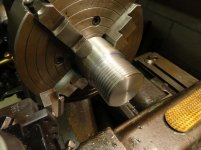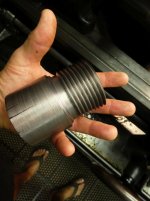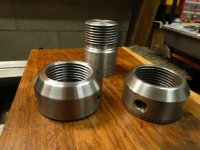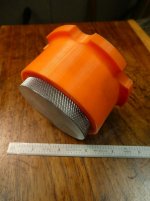Big = Relative I know!
I am going to make a new spindle collar for use with my collets. The one I'm using is really ugly to look at and so away I go.
Until I am better, could be never, at using the machinists handbook to understand all the ways to measure threads I feel much better having a test thread in hand to check for fit.
So I made a male threaded part with 2 3/8-6 threads as a first step. I didn't respect the extra forces involved in cutting this large of a thread and ended up breaking the Aloris insert! Nice 52 dollar mistake. Sort of lucky that I am on a belt driven lathe too! Got a little slip in the second and a half reaction to shutting her down!
Anyway they turned out really well after some clean up so I figured I'd start a thread to hear of others adventures with "big" threads...and the anticipated "you think that's a big thread son" discourse that I enjoy! "Why back in my day we single pointed rail road wheel shafts and screwed 'em on and sent them off to war!"

Next to the collar I plan on making next.

Perfect fit

I need to find a nice safe place to keep this puppy since I may have a need for a spindle thread ref in the future.

I am going to make a new spindle collar for use with my collets. The one I'm using is really ugly to look at and so away I go.
Until I am better, could be never, at using the machinists handbook to understand all the ways to measure threads I feel much better having a test thread in hand to check for fit.
So I made a male threaded part with 2 3/8-6 threads as a first step. I didn't respect the extra forces involved in cutting this large of a thread and ended up breaking the Aloris insert! Nice 52 dollar mistake. Sort of lucky that I am on a belt driven lathe too! Got a little slip in the second and a half reaction to shutting her down!
Anyway they turned out really well after some clean up so I figured I'd start a thread to hear of others adventures with "big" threads...and the anticipated "you think that's a big thread son" discourse that I enjoy! "Why back in my day we single pointed rail road wheel shafts and screwed 'em on and sent them off to war!"


Next to the collar I plan on making next.

Perfect fit

I need to find a nice safe place to keep this puppy since I may have a need for a spindle thread ref in the future.
















